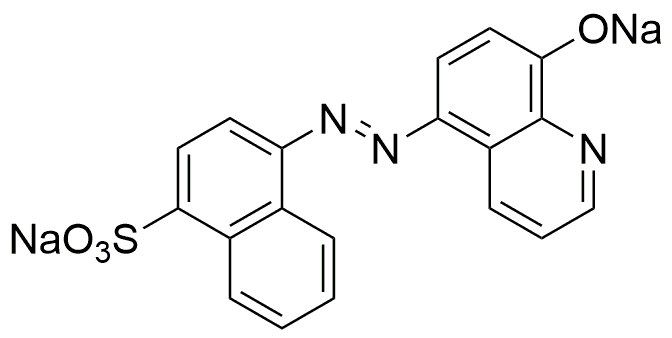4-(8-Hydroxy-5-quinolylazo)-1-naphthalenesulfonic acid disodium salt is widely utilized in research focused on:
- Colorimetric Assays: This compound is often used as a dye in colorimetric assays, allowing for the quantification of various analytes in biological and environmental samples. Its vibrant color change makes it easy to detect and measure concentrations.
- Biochemical Research: In biochemistry, it serves as a reagent for studying enzyme activities and interactions, particularly in assays that require a visual indicator of reaction progress.
- Textile Industry: The compound is applied in the textile industry for dyeing fabrics, providing bright and stable colors. Its properties ensure that colors remain vibrant even after washing.
- Analytical Chemistry: It is used in analytical methods for detecting metal ions, where it forms stable complexes, facilitating the analysis of environmental samples for pollutants.
- Pharmaceutical Development: In drug formulation, it acts as a pH indicator, helping researchers to monitor the acidity levels during the development of various pharmaceutical products.
General Information
Properties
Safety and Regulations
Applications
4-(8-Hydroxy-5-quinolylazo)-1-naphthalenesulfonic acid disodium salt is widely utilized in research focused on:
- Colorimetric Assays: This compound is often used as a dye in colorimetric assays, allowing for the quantification of various analytes in biological and environmental samples. Its vibrant color change makes it easy to detect and measure concentrations.
- Biochemical Research: In biochemistry, it serves as a reagent for studying enzyme activities and interactions, particularly in assays that require a visual indicator of reaction progress.
- Textile Industry: The compound is applied in the textile industry for dyeing fabrics, providing bright and stable colors. Its properties ensure that colors remain vibrant even after washing.
- Analytical Chemistry: It is used in analytical methods for detecting metal ions, where it forms stable complexes, facilitating the analysis of environmental samples for pollutants.
- Pharmaceutical Development: In drug formulation, it acts as a pH indicator, helping researchers to monitor the acidity levels during the development of various pharmaceutical products.
Documents
Safety Data Sheets (SDS)
The SDS provides comprehensive safety information on handling, storage, and disposal of the product.
Product Specification (PS)
The PS provides a comprehensive breakdown of the product’s properties, including chemical composition, physical state, purity, and storage requirements. It also details acceptable quality ranges and the product's intended applications.
Certificates of Analysis (COA)
Search for Certificates of Analysis (COA) by entering the products Lot Number. Lot and Batch Numbers can be found on a product’s label following the words ‘Lot’ or ‘Batch’.
Número de catálogo
Número de lote/lote
Certificates Of Origin (COO)
This COO confirms the country where the product was manufactured, and also details the materials and components used in it and whether it is derived from natural, synthetic, or other specific sources. This certificate may be required for customs, trade, and regulatory compliance.
Número de catálogo
Número de lote/lote
Safety Data Sheets (SDS)
The SDS provides comprehensive safety information on handling, storage, and disposal of the product.
DownloadProduct Specification (PS)
The PS provides a comprehensive breakdown of the product’s properties, including chemical composition, physical state, purity, and storage requirements. It also details acceptable quality ranges and the product's intended applications.
DownloadCertificates of Analysis (COA)
Search for Certificates of Analysis (COA) by entering the products Lot Number. Lot and Batch Numbers can be found on a product’s label following the words ‘Lot’ or ‘Batch’.
Número de catálogo
Número de lote/lote
Certificates Of Origin (COO)
This COO confirms the country where the product was manufactured, and also details the materials and components used in it and whether it is derived from natural, synthetic, or other specific sources. This certificate may be required for customs, trade, and regulatory compliance.


